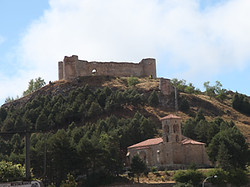
Visitors today approaching Santa Cecilia will probably see the church and the castle of Aguilar de Campoo as one cohesive entity with the hill they both stand on, with the church on the southeast slope of the hill and crowned by the castle that breaks the skyline. The view probably would not have been all that different in the Middle Ages, since the area around the castle and Santa Cecilia formed one of the early urban settlements of Aguilar in the late-twelfth to thirteenth century (1). The origins of Santa Cecilia itself are not certain - there seems to have been documentary evidence of a construction stone with inscriptions that date the church back to 1041, during the reign of Fernando I (r. 1037-1065) and Queen Sancha of León, but since there is now no trace of this stone, this claim is tenuous at best (2). The oldest part of the church as it stands today dates back to the late-twelfth century, with slightly later expansions in the early-thirteenth century, putting it roughly contemporaneous with the monastery of Santa María la Real (3). There were later restorations, in the sixteenth to eighteenth centuries (the rebuilding of the central apse and presbytery to replace the collapsed ones), and then again in the 1960s (4).
There are several vegetal capitals at the church of Santa Cecilia, including the ones at the main portal on the south façade and many along the nave, but there are also capitals with animal and fantastical creature motifs, as well as biblical scenes - including the much praised capital of the Massacre of the Innocents on the left side of the triumphal arch (5). Scroll down to explore in details this historiated capital.
Church of Santa Cecilia
Massacre of the Innocents capital
The texture of chainmail almost fills up the entire capital as the soldiers clad in it all hold out their swords, about to kill the infants. King Herod, who gave the order, stands at the right-hand corner. We can also see stricken faces of mothers peeking out from behind the soldiers, their hands held up to their faces in a gesture of mourning. This capital has been praised as the highest-quality sculptural work at Santa Cecilia, and an outstanding piece in Romanesque Palencia (6).
Interestingly, there is a very similar capital originally from the nearby monastery of Santa María la Real - now preserved in the Museo Arqueológico Nacional of Madrid - although it is a double-capital and was originally placed in the cloister while this one adorns the triumphal arch inside the church of Santa Cecilia (7).
Notes
(1) Rafael Paradelo, "Aguilar de Campoo," in Enciclopedia del románico en Castilla y León: Palencia, eds. José María Pérez González, Miguel Ángel García Guinea and José Manuel Rodríguez Montañés (Aguilar de Campoo: Fundación Santa María La Real, Centro de Estudios del Románico, 2002), 167; José Luis Hernando Garrido and Jaime Nuño González, "La Iglesia Tardorrománica de Santa Cecilia en Aguilar de Campoo (Palencia)," Codex aquilarensis: Cuadernos de investigación del Monasterio de Santa María la Real 7 (1992): 11-14.
(2) Hernando Garrido and Nuño González, "La Iglesia Tardorrománica de Santa Cecilia en Aguilar de Campoo (Palencia)," 11-12; Artemio Manuel Martinez Tejera, "Aguilar de Campoo: Ermita de Santa Cecilia," in Enciclopedia del románico en Castilla y León: Palencia, 174.
(3) Hernando Garrido and Nuño González, "La Iglesia Tardorrománica de Santa Cecilia en Aguilar de Campoo (Palencia)," 12-15, 66; Martinez Tejera, "Aguilar de Campoo: Ermita de Santa Cecilia," in Enciclopedia del románico en Castilla y León: Palencia, 175-77.
(4) Hernando Garrido and Nuño González, "La Iglesia Tardorrománica de Santa Cecilia en Aguilar de Campoo (Palencia)," 62-68; Martinez Tejera, "Aguilar de Campoo: Ermita de Santa Cecilia," in Enciclopedia del románico en Castilla y León: Palencia, 174, 177.
(5) For a comprehensive description and analysis of the sculptural details at Santa Cecilia, see Hernando Garrido and Nuño González, "La Iglesia Tardorrománica de Santa Cecilia en Aguilar de Campoo (Palencia)," 17-58; see also Martinez Tejera, "Aguilar de Campoo: Ermita de Santa Cecilia," in Enciclopedia del románico en Castilla y León: Palencia, 177-79.
(6) Hernando Garrido and Nuño González, "La Iglesia Tardorrománica de Santa Cecilia en Aguilar de Campoo (Palencia)," 38-43; Martinez Tejera, "Aguilar de Campoo: Ermita de Santa Cecilia," in Enciclopedia del románico en Castilla y León: Palencia, 177-79.
(7) Hernando Garrido and Nuño González, "La Iglesia Tardorrománica de Santa Cecilia en Aguilar de Campoo (Palencia)," 37-38; Martinez Tejera, "Aguilar de Campoo: Ermita de Santa Cecilia," in Enciclopedia del románico en Castilla y León: Palencia, 177-79.




